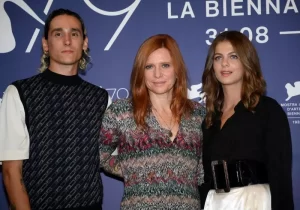by Ivana Risitano – I have, hanging next to the bed, a postcard with a painting of Simone Martini: a Clare with tilted head, holding a flower, veil and halo on her head. The Chiara that I carry in her eyes tonight is different: her hair is scattered and free, the rough tunic, the bloody hands. “I didn’t mean to scare!”. Many women think so when the power of the Feminine releases from their bodies the strength of “miracles”. I don’t want, with this, to reduce the special character of the spirituality of Clare of Assisi: rather, I want to grasp what is universal, beyond space and time, in his experience. I believe that a film, like any work of art, shouldn’t be asked for a faithful historical reconstruction: there can be one, yes; but a film transfigures: it is the encounter between that story, that life, and the images that that story arouses in the director, and then, again, between the director’s imagination and us, each of us who, during the an experience.
The film by Susanna Nicchiarelli he does not dwell on the mystical dimension: there are few scenes of prayer, few references to contemplative silences and corporal renunciations. But there are scenes which, beyond the faithful and literal adherence to the story, contain a powerful message. There are the scenes of anger, those screams and outstretched hands: the missed gesture, the frustration in the face of the arrogance of machismo, but also the spokesperson for everyone, coreuta and sister who is sometimes also a mother, and leader. There are the scenes of women’s dances, among the most beautiful for me: that harmony of different bodies capable of composing a unitary and beautiful form, silhouetted on the stage of Mother Nature or gathered in the womb of a church. And then the veils removed one by one from the hair, and the clothes discarded; and the gift of dolls to leper children – because love is sometimes giving the “superfluous”, next to the essentials; and the steps of the sisters like a chorus of Greek tragedy; and the incredulous faces of Chiara in front of the miracles that “they run away” from the hands, a sign of entrustment to God who gives her back a hundredfold, and transships from her skin and even from her conscious will. To each a film touches some chords and not others. That of parrhesia resonated with me: not only the courage of gestures, but also that of speaking clearly. And, next to it, that of movement. I won’t deny that for years I have associated the enclosure with a form of static, in which the only movement I perceived was that of the soul merging with the Creator. Now I have, next to this image of Chiara, that of other movements: that of the word, of the dialectic, of insistence too, and of the proposal, and of denunciation, and of “claim”; and the desire to leave, to explore, to be among people; and then the movement of Desire, from which all this springs: because Chiara doesn’t throw tantrums, she is simply in tune with the depths of herself, that interiority in which the Truth dwells.
In the end, the movement of Creation: create a sorority, create a dimension of Care, create a Rule (which, more than as a Rule, is perhaps important because it does not leave women behind compared to men, and because it allows for the creation of an enclosure for those desires and wills, which not a cage but protection, a secure base from which to realize a vocation beyond the pressures of the worldly).
In the film, the “political” dimension (in the noblest sense of the term) and the spiritual and existential one are intertwined. Clear fight against the ipse dixit, against the prevailing male chauvinism, against the physical and psychological violence of bullies, against the greed for power and profit, and opens new paths where it was not thought possible. Clare hears the voice of Godand listens to her by contacting her most intimate essence, as well as in the looks and smiles exchanged with her sisters, and in the immensity of Creation: sincere with herself, and able to tune in with the Other in that communion that comforts and strengthens .
Thus, next to the little image of Chiara with the flower in her hand, I place that of a Chiara of dance and nonviolent struggle… and I leave space for all those images that will come, within a History that still has too many imbalances of power and too much fear of the Feminine.
The film Chiara: when the power of the Feminine unleashes the strength of “miracles” – The Sycomoro

